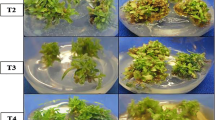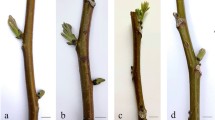Abstract
This study was initiated to determine whether antibiotic pulse treatments (APT) could effectively eliminate internal infections of ginseng (Panax ginseng) root explants containing vascular tissue, and subsequently have post-treatment effects on changing explant behaviors in callus induction and organogenesis or somatic embryogenesis. For contamination control, a treatment of 40 min with an antibiotic solution consisting of 1000 mg/1 of penicillin-G and 1000 mg/1 of streptomycin immediately following Na-hypochlorite sterilisation significantly decreased contamination rate. Extending treatment time to 2–3 h further lowered the contamination rate to 30–40%. On the other hand, explants treated with antibiotics for 20 min or less were all contaminated. APT also had post-treatment effects; it delayed callus induction for 1–12 months depending on pulse duration and stimulated the generation of more hardand darker looking than fragile- and lighter looking callus. The induced callus proliferated at a depressed rate, increasing subculture intervals from 1 to several weeks, and not until after five subcultures did it fully recover. The regeneration ability of the recovered callus was also affected by APT: the regeneration of adventitious roots was promoted, whereas somatic embryos were not observed.
Similar content being viewed by others
Abbreviations
- APT :
-
Antibiotic pulse treatments
- 2,4-D :
-
2,4-dichlorophenoxyacetic acid
References
Borrelli GM, DiFonzo N, Lupotto E (1992) Effect of cefotaxime on callus culture and plant regeneration in durum wheat. J Plant Physiol 140:372–374
Chiariello NR, Gulmon SL (1991) Stress effects on plant reproduction. In: Mooney HA, Winner WE, Pell EJ (eds) Response of plants to multiple stresses. Academic Press, New York, pp 162–188
De KK, Roy SC (1990) Effect of antibiotics on plant tissues in vitro. Bangladesh J Bot 19:219–222
Debergh PC, Coster G de, Steurbaut W, Columbia MD (1993) Carbendazim as an alternative plant growth regulator in tissue culture systems. In Vitro Cell Dev Biol Plant 29P:89–91
Falkiner FR (1990) The criteria for choosing an antibiotic for control of bacteria in plant tissue culture. Int Asso Plant Tissue Cult Newsl 60:13–23
Gilbert JE, Shohet S, Caligari PDS (1991) The use of antibiotics to eliminate latent bacterial contamination in potato cultures. Ann Appl Biol 119:113–120
Grim JP, Campbell BD (1991) Growth rate, habitual productivity, and plant strategy as predictors of stress response. In: Mooney HA, Winner WE, Pell EJ (eds) Response of plants to multiple stresses. Academic Press, New York, pp 143–161
Hammerschlag FA, Zimmerman RH, Yadava UL, Hunsucker S, Gercheva P (1995) An evaluation of antibiotics for the elimination ofAgrobacterium tumefaciens from apple leaf explants in vitro and for the effect on regeneration (Abstr). HortScience34:876
Holford P, Newbury HJ (1992) The effects of antibiotics and their breakdown products stimulated the in vitro growth ofAntirrhinum majus. Plant Cell Rep 11:93–96
Kneifel W, Leonhardt W (1992) Testing of different antibiotics against gram-positive and gram-negative bacteria isolated from plant tissue culture. Plant Cell Tissue Organ Cult 29:139–144
Leifert C, Camotta H, Waites WM (1992) Effect of combinations of antibiotics on microprogatedClematis, Delphinium, Hosta, Iris andPhotinia. Plant Cell Tissue Organ Cult 29:153–160
Murashige T, Skoog F (1962) A revised medium for rapid growth and bioassays with tobacco tissue cultures. Physiol Plant 15: 473–497
Nakano M, Mii M (1993) Antibiotics stimulate somatic embryogenesis without plant growth regulators in several dianthus cultivars. J Plant Physiol 141:721–725
Pierik RLM (1989) Sterilisation of plant material. In: Pierik RLM, In vitro culture of higher plants. Martinus Nijihoff Publ, Dordrecht, pp 87–94
Staritsky G, Hovers IHW, Zandvoort EA (1983) Rifampicin, an effective antibiotic against bacteria in cultures in vitro. Acta Bot Neerl 33:491
d'Utra Vaz FB, dos Santos AVP, Manders G, Cocking EC, Davey MR, Power JB (1993) Plant regeneration from leaf mesophyll protoplast of the tropical woody plant, passionfruit (Passifora edulis fv flavicarpa Degener.): the importance of the antibiotic cefotaxime in the culture medium. Plant Cell Rep 12:220–225
Wilson ZA, Power JB (1989) Elimination of systemic contamination in explants and protoplast cultures of rubber (Hevea brasiliensis Muell. Arg.). Plant Cell Rep 7:622–625
Yepes LM, Aldwinckle HS (1994) Factors that affect leaf regeneration efficiency in apple, and effect of antibiotics in morphogenesis. Plant Cell Tissue Organ Cult 37:257–269
Author information
Authors and Affiliations
Additional information
Communicated by G. Phillips
Rights and permissions
About this article
Cite this article
Teng, W.L., Nicholson, L. Pulse treatments of penicillin-G and streptomycin minimise internal infections and have post-treatment effects on the morphogenesis of ginseng root culture. Plant Cell Reports 16, 531–535 (1997). https://doi.org/10.1007/BF01142318
Received:
Revised:
Accepted:
Issue Date:
DOI: https://doi.org/10.1007/BF01142318




